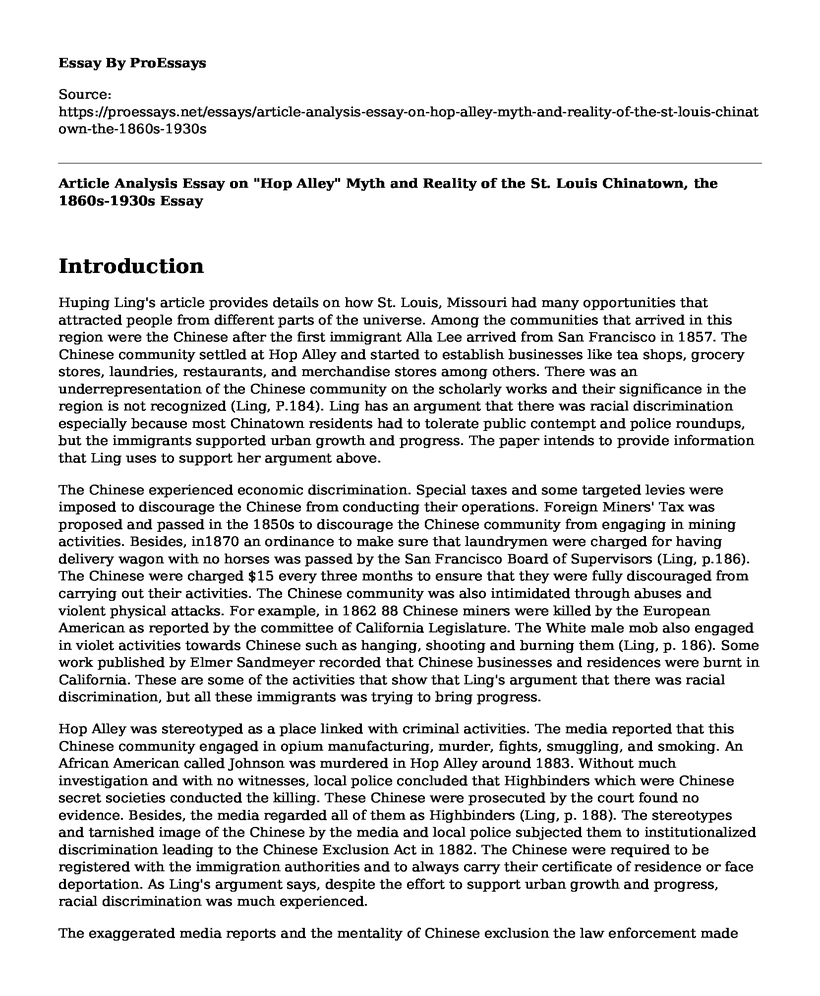Introduction
Huping Ling's article provides details on how St. Louis, Missouri had many opportunities that attracted people from different parts of the universe. Among the communities that arrived in this region were the Chinese after the first immigrant Alla Lee arrived from San Francisco in 1857. The Chinese community settled at Hop Alley and started to establish businesses like tea shops, grocery stores, laundries, restaurants, and merchandise stores among others. There was an underrepresentation of the Chinese community on the scholarly works and their significance in the region is not recognized (Ling, P.184). Ling has an argument that there was racial discrimination especially because most Chinatown residents had to tolerate public contempt and police roundups, but the immigrants supported urban growth and progress. The paper intends to provide information that Ling uses to support her argument above.
The Chinese experienced economic discrimination. Special taxes and some targeted levies were imposed to discourage the Chinese from conducting their operations. Foreign Miners' Tax was proposed and passed in the 1850s to discourage the Chinese community from engaging in mining activities. Besides, in1870 an ordinance to make sure that laundrymen were charged for having delivery wagon with no horses was passed by the San Francisco Board of Supervisors (Ling, p.186). The Chinese were charged $15 every three months to ensure that they were fully discouraged from carrying out their activities. The Chinese community was also intimidated through abuses and violent physical attacks. For example, in 1862 88 Chinese miners were killed by the European American as reported by the committee of California Legislature. The White male mob also engaged in violet activities towards Chinese such as hanging, shooting and burning them (Ling, p. 186). Some work published by Elmer Sandmeyer recorded that Chinese businesses and residences were burnt in California. These are some of the activities that show that Ling's argument that there was racial discrimination, but all these immigrants was trying to bring progress.
Hop Alley was stereotyped as a place linked with criminal activities. The media reported that this Chinese community engaged in opium manufacturing, murder, fights, smuggling, and smoking. An African American called Johnson was murdered in Hop Alley around 1883. Without much investigation and with no witnesses, local police concluded that Highbinders which were Chinese secret societies conducted the killing. These Chinese were prosecuted by the court found no evidence. Besides, the media regarded all of them as Highbinders (Ling, p. 188). The stereotypes and tarnished image of the Chinese by the media and local police subjected them to institutionalized discrimination leading to the Chinese Exclusion Act in 1882. The Chinese were required to be registered with the immigration authorities and to always carry their certificate of residence or face deportation. As Ling's argument says, despite the effort to support urban growth and progress, racial discrimination was much experienced.
The exaggerated media reports and the mentality of Chinese exclusion the law enforcement made assumptions that Chinese cities had a lot of criminals and illegal laborers. Local authorities deported a lot of Chinese. The Chinatown was demonized and people started escaping those areas. The children were told to avoid the Chinese community (Ling, p. 189). It's an indication that despite the effort of Chinese to progress the urban, discrimination was massively experienced.
Work Cited
Ling, Huping. "Hop Alley" Myth and Reality of the St. Louis Chinatown, the 1860s-1930s." Journal of Urban History 28.2 (2002): 184-219.
Cite this page
Article Analysis Essay on "Hop Alley" Myth and Reality of the St. Louis Chinatown, the 1860s-1930s. (2023, May 12). Retrieved from https://proessays.net/essays/article-analysis-essay-on-hop-alley-myth-and-reality-of-the-st-louis-chinatown-the-1860s-1930s
If you are the original author of this essay and no longer wish to have it published on the ProEssays website, please click below to request its removal:
- On the Duty of Civil Disobedience - Essay Analysis
- Response to From One Second to Another Documentary Essay Example
- A Discussion on Childhood Obesity Essay
- Article Analysis Essay on Energy for Poverty Reduction
- Essay Sample on the Role of Harvey Bernard Milk in the LGBT Community
- Women Unite: Demanding Equality and Equal Rights in the 21st Century - Essay Sample
- Paper Example on National Immigration Policy: Who Should Regulate?







